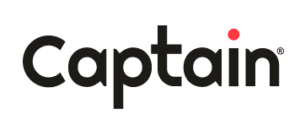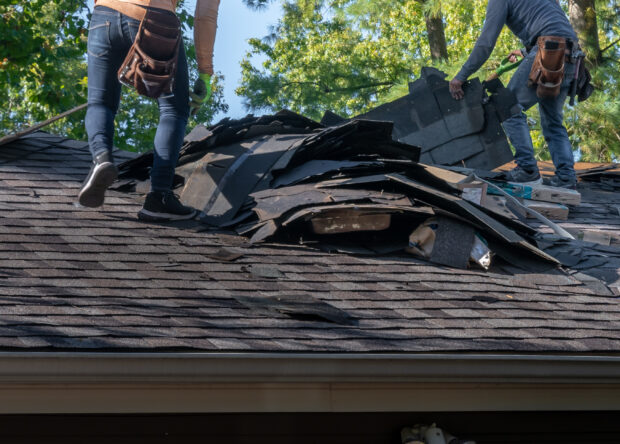When former accountant and roofing contractor Demetrius Gray talks about his personal journey to become founder of a fintech with ties to the insurance industry, he doesn’t dwell on the challenges for even a second.
Executive Summary
Demetrius Gray, the CEO and founder of Captain, spoke to Carrier Management soon after Captain announced that it emerged from stealth mode with $104 million in financing. Gray, a second-time founder who previously led a property damage prediction company known as WeatherCheck, explained what he learned from his prior experience: that alerting homeowners and carriers to hail or wind damage isn’t enough to get victims of natural disasters back in their homes quickly. Contractors need funding and the incentives to make it happen.Still, it can’t be easy to move from the back office up to the top of a residential property—literally standing on the shingles—and then to dive into entrepreneurship with a mission to help homeowners recover quickly after natural disasters by advancing capital to building contractors, not to mention also founding the first Black-owned InsurTech meteorology company in the U.S. along the way.
“It’s not that it’s easy. But frankly, we don’t have the hard part. The hard part is what the policyholder is having to do. They’re having to put their life back together. That’s much harder,” he told Carrier Management when asked about that during a recent interview. “We keep that top of mind.”
Gray lists contractor struggles next when ranking post-disaster difficulties. “Finally, then it’s the insurer and us—[and] I would say probably the insurer has a harder time than we do because sometimes they have to say no.”
Once an insurer says yes to a natural disaster claim from a home insurance policyholder, Gray’s company, known as Captain, essentially buys the insurance receivable and loans capital to contractors to get the work done more quickly than had been the case in the past. Captain helps homeowners get their repairs completed within 30 days by advancing money to their contractors to pay for materials, labor and fees associated with repairs. For storms like Hurricane Katrina or Sandy, the average primary recovery period was 14 months, with smaller storms still requiring up to five months for repairs and financing, Captain said in a media statement in March in which the fintech also announced that it raised with $104 million. The total financing consisted of $100 million in debt financing from CoVenture and a $4 million seed round backed by NFX, GGV Capital and Red Swan.
“We’re here to help grease the skids” as rebuilding moves forward, said Gray during a video interview, which was posted online as part of this publication’s recent InsurTech Summit 2022 conference content. The theme of the Summit was “Towards a Safer, Smarter, Better World,” and Captain fit that ESG focus in more ways than one.
“We consider ourselves, yes, a fintech but also a climate tech company,” Gray said, stressing an idea that is top of mind for the property/casualty insurance industry: “We have to adapt to this new normal of the number of events.”
 “Really the intent here is to create a new institutional asset class of a claim-backed security, so that it’s seen as something that is a sure bet.”
“Really the intent here is to create a new institutional asset class of a claim-backed security, so that it’s seen as something that is a sure bet.” Demetrius Gray, Captain
“I’m from Western Kentucky. I grew up in a town that was impacted by the tornadoes,” he said. “This ability to step into the moment is really what frankly gets us up every day,” Gray said, referring to a team of 12 Captain employees with ambitions to be a staff of 50-75 by year-end. “There are just real, tangible benefits in being a part of that third wave that comes in after those events.”
Also in that wave are contractors, “who frankly are doing more work because of our capital. They’re growing. They’re becoming more stable. They’re refining their processes and becoming really, really great businesses,” Gray said, giving the example of a small Black-owned contractor named DCD Construction in Ohio. With Captain buying insurance receivables, “it became easy for him. Easier,” Gray said, referring to an impactful DEI follow-on effect of Captain’s business proposition. Referring to a volatile period in terms of race relations, Gray said he is encouraged. “We’re excited about that part—stabilizing some of these companies.”
Aligning Incentives
Gray is a second-time tech company founder, having previously launched WeatherCheck, a Y-combinator company involved in weather damage prediction that monitored properties for hail damage. It was during his time running WeatherCheck that Gray recognized the need for a financial technology company like Captain, he said.
“What became apparent was that you could create really, really high-quality data around insurance losses, and predictive analytics around whether or not somebody had been impacted at a specific property. But if the financial incentives weren’t actually aligned, then it really didn’t make much sense to provide that high-quality data,” he said, finding an answer to a question he kept coming back to—about why property damage claims were moving so slowly even as technology advanced.
“The epiphany that we really had was that there was actually nobody fronting any money, which was making the carriers sometimes squeamish about what’s actually happening.”
“We really have tried to help Wall Street meet Main Street so that there is liquidity, so that it’s not the carrier taking the financial risk. They’re certainly approving a claim. But [then Captain is] really helping the contractor through the process so he doesn’t feel like he needs to supplement and do all these other things in the process of working these claims,” he said, referring to the possibility that contractors feel they need to overbill to make a profit.
Gray walked Carrier Management through the post-disaster process for a homeowner needing a roof repair.
“Frankly, carriers have already done a very good job of getting to the insured at FNOL [first notice of loss]. The insured calls, files a claim, and the carrier is pretty good in most cases about getting to the insured person and making their initial adjustment. It’s really after that moment that we have a long tail…Does the insured know what to do next? Have they identified a good contractor?”
With Captain in the mix, what happens next is that Captain lets the insurers know that the fintech has vetted a group of contracting firms to which it is willing to front money. “The insured then says, ‘OK. We are actively going to let you handle our claim with this particular contractor…”
Captain steps in to pay all the associated bills in accordance with the estimate the insurance company has already provided, Gray explained. That allows two things to happen that aren’t happening today. “Now, Captain has all the metadata on what we actually spent money on. Then secondarily, [for] the insured, we’ve also mitigated all the potential lien risk that exists today,” he said, explaining that if the contractor doesn’t pay their material bill or laborers, then suppliers and subcontractors can lien the policyholder.

Those potential risks pop up even though the insurance company is doing what it’s supposed to do. Captain steps in to mitigate all that risk—”and as a result, we move the claim along faster, moving that 180-day claim down to right around 30.”
Gray gave more insight into the reasons for speedier repairs as he answered the question of how Captain makes money through loans to contractors.
“We charge the contractor, and the contractor pays us out of his profits. We charge them 5 percent on the face value of every single claim, and we charge them that every 30 days…Now there’s a complete incentive for the contractor to move quickly to get the work done…There’s no longer a long tail because it’s costing him more over time,” he said.
“The best contractors in our cohort actually will move our claims up in front of the rest of their queue because they want those things done. That’s really what Captain has done with this capital—[introduced] a really embedded finance approach to what we all know has been a long problem.”
The technology part of the term fintech, he said, “is 100 percent about automating the underwriting of the actual insurance company’s estimate up against contractor’s market pricing. If you think about it in the context of what Xactimate does today, Xactimate scans the field and says, ‘Periodically, we’re going to get pricing’ related to the cost of repair work,'” he said referring to well-known claims estimating software from Verisk. “What Captain says is, ‘No, we have dynamic pricing right now,’ and [then asks], ‘Does our pricing across all of our contractors fit within the context of what that Xactimate estimate said?'”
Captain is in the position, then, to advise the contractor about whether working on the claim will produce a baseline level of profitability that the contractor needs.
“A lot of times I think there is certainly a game, a world in which contractors are trying to bill the insurance company for as much as possible,” Gray said. Captain advises against this and still puts contractors on the path to profitability. “We give this to them in our playbook for profitability,” said Gray, who is an accountant by training and also once led a roofing company himself. Captain tells contractors, “You need a baseline, a number that you are willing to work from. If there are supplements beyond that, you really shouldn’t pursue those because you’ve gotten the profitability that you need to make sure your company is growing well over time.”
“Some of the challenge in the [repair] industry today is that they’re not sure what level of profitability they’re going to get from claim to claim. What Captain really does through its technology is say, ‘Ah, OK. Yes. This does fit within your baseline level of profitability. Yes, you should do this claim and then move forward.'”
Gray added, “Contractors have a difficult job. They need to be heavily focused on doing a really, really great job on the work that they’ve been tasked to do…With Captain, they get to focus on that one thing. The administrative and clerical side of trying to make sure that the insurance company is billed at the right time and they get all the necessary documentation is something that Captain takes away from them so that they can focus.”
Captain also does all the legal due diligence for the contractor to make sure that their contracts are fully enforceable in every single state. That means insureds benefit “because now they’re getting all of the consumer protections, all of the things that maybe were omitted in these older three-ply contracts that are just sign-on-the-dotted-line” situations.
From InsurTech to Fintech
Beyond mitigating lien risk for policyholders, Gray envisions Captain evolving to a point where the fintech can give insureds more financial products to mitigate risk in the future. “When you think about things like deductible financing and insurance-backed warranties and non-structural warranties over the long run, those are the things that Captain is frankly interested in.”
In that vein, Gray rejects a description of Captain as a “managed repair network” that people often suggest. “Really, no. We’re a marketplace that’s building the financial tech stack for disaster—frankly, all of the tools will be there to de-risk the transaction financially so that everybody’s good.”
Reflecting again on his experience with WeatherCheck, Gray said, “We certainly found that carriers do like to maintain an arm’s length transaction with the policyholder—and regulators are requiring it. In a lot of ways, what Captain allows for the carrier to do is increase customer satisfaction while not having to maintain these ingrained and entrenched managed repair programs where they’re taking on liability. But then [they are] also getting clarity into what is actually happening,” Gray said, noting that Captain maintains a portal for carriers to go in and see progress information.
“How far along are they? Is the project done? They’re invited into that immediately upon us getting the claim. Those insights, giving them metadata on [questions like], ‘Is our insured good? Are they satisfied?'”
Part of WeatherCheck’s mission as a damage prediction platform was to allow insurers to notify policyholders. “What we really found is that it really violated the fiduciary responsibility of the carrier to know which policyholders actually had valid claims because it screwed up the balance sheet in terms of having to reserve capital up against these potential losses,” Gray said.
Captain’s mission leverages the value of weather prediction data differently. “WeatherCheck’s data will help power our underwriting in Captain, but moreover it will also help increase the overall deployment of capital up against losses. When we think about partnering with carriers down the road, it’s about ensuring that we can feed the beast that is the capital markets, who are looking for ability to deploy capital,” Gray said.
While WeatherCheck was mainly involved with hail claims, Gray confirmed that Captain is going to be involved with other perils, such as tornado and wildfire as well. “From a funding perspective, we are preparing for large and complex losses,” he said, noting that Captain has already approved its first $1 million-plus wildfire claim for funding.
Asked to describe the challenges he’s faced so far in building a fintech, Gray said “creating a path to communicate with carriers is always one of the hard parts. Depending on what carrier you’re dealing with, it can really prolong the overall process.”
“The thing I really generally want to say to most carriers is [that] we’re here to make the process move faster. Don’t get worried. Don’t get trepidatious. Frankly, we don’t want any of these to go to litigation. We don’t want them to go to appraisal. We just want to get them [moving] forward because, frankly, it goes far better for us in the long run. And lenders have given us capital for this reason.”
What about the lenders? How did Gray convince them that this is a good idea?
“The reality is that 80 percent of all claims are paid—80 percent. That’s a really great risk,” Gray said. “We’re not really playing in the pool of the remaining 20.
“We’re saying, ‘Hey, for this 80 percent, we can improve satisfaction so much that really, frankly, we think we can actually have a knock-on effect on the remaining 20. Really the intent here is to create a new institutional asset class of a claim-backed security, so that it’s seen as something that is a sure bet…”
“That’s how our financiers are looking at this, saying, ‘Yes, in order for us to go through this next phase of this climate emergency that we’re in, we’re going to need to find alternative solutions for funding these events.'”
“Frankly, eventually we think that will supersede insurance and it will eventually transcend to federal government payments and the like.”
The Last Mile: The Insurance Deductible
“There is a level of complexity that even goes beyond the carrier, as you start to deal with FEMA dollars, as you start to deal with local and state grants that insureds are receiving after a disaster, especially in the event of a total loss.” Captain can step in there to guide disaster victims, too, Gray believes.
What else is on the horizon for Captain?
“There are so many financial products that don’t exist yet,” Gray said, following up on an earlier comment about insurance-backed home warranties and insuring deductibles. “When we think about the larger carrier relationship over the long haul, it is really [about] building out those financial products so that they’re available for the policyholder at the point of sale, so that the carrier can feel comfortable that there’s solid workmanship warranty behind the contractors.”
Describing a potential gap insurance product that would cover insurance deductibles, the fintech founder confirmed that it’s something Captain is interested in pursuing in the future. “I call it the last mile of insurance, which is the insurance deductible. It really is this thing that we have to figure out,” he said, referring to the question of how to take away pressure off insureds who have deductibles averaging $1,000 or $2,500 on their homeowners policies.
Speaking on a Nov. 24, 2019 podcast posted online by Innovator’s Edge and a separate Sept. 20, 2019 podcast published by FNO: InsureTech (both unaffiliated with CM), Gray suggested that increasing deductibles are “breaking the system” of post-disaster repair because they remove incentives for policyholders to further protect their properties—a situation that could eventually result in a trend in deteriorating the housing stock that P/C carriers have to underwrite. In fact, high deductibles can work against carrier goals as insureds seek cheaper contractors to minimize the amount of cash they have to lay out—a situation that parametric insurance solutions may be able to fix, he said during those 2019 online interviews.
Speaking on the more recent Carrier Management video interview, Gray said he’s thinking beyond the problems of insureds with large deductibles. “We’re also looking even at underinsureds and folks who don’t have insurance at. All of those things are on the table.”
The name of the fintech sums up much of Gray’s thinking overall on insurance claims. “What we think policyholders need is a Captain. Somebody to marshal the actual overall process post-claim.”
“What we have to remember is that there are two sides to this contract that this policyholder is in: the insurer side, and then the policyholder side. So, what Captain really is about is really moving the policyholder through that process accordingly so that there’s success.”
“Nobody wants a dispute. Nobody wants the claim to be impaired. We really just want to get the policyholder whole. And that is the basis of the resilience work that we’re doing.”
(Related online bonus article, “A Fintech Founder’s Backstory: Who Is Demetrius Gray?”)





















 AI in Property/Casualty Insurance: Why Trusted Data Is the Missing Link
AI in Property/Casualty Insurance: Why Trusted Data Is the Missing Link  The Good Neighbor
The Good Neighbor  What Progressive and GEICO Q3 Results Reveal About Auto Insurance Profit, Growth
What Progressive and GEICO Q3 Results Reveal About Auto Insurance Profit, Growth  Executive Utterances: On Presenting
Executive Utterances: On Presenting 




